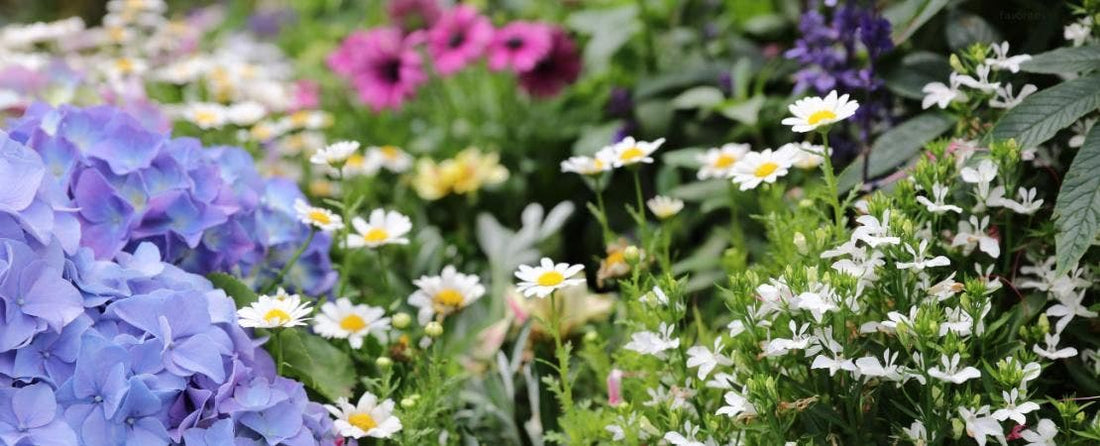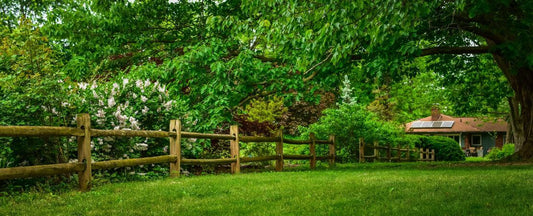Customer's Favorite Low-Maintenance Perennials

Recommended by Fellow Gardeners: Why You'll Want to Plant Them, Too
At Wayside Gardens, we know that our customers value their time just as much as they value their gardens. That’s why we asked our followers on social media to share their favorite no-fuss, low-maintenance perennials. Their responses highlighted a fantastic selection of plants that are not only easy to care for but also deliver stunning beauty year after year. Here is an inspirational guide to these customer favorites, with details about what makes them great choices and tips for including them in your garden.
Hydrangeas
Hydrangeas are beloved for their large, showy blooms that come in various colors, including blue, pink, white, and purple. These perennials are incredibly versatile and can thrive in a range of conditions.
What is Special About Hydrangeas?
- Long Bloom Period: Hydrangeas offer a long season of interest, with flowers that can last from early summer to fall.
- Different Types for Different Growing Conditions: Panicle hydrangeas tolerate more sun, macrophylla hydrangeas prefer shade. Learn more about hydrangea types and care.
- Soil Adaptability: They can grow in various soil types, although they prefer well-drained, fertile soil.
Low-Maintenance Tips for Hydrangeas
- Prune in late winter or early spring(depending on the type of hydrangea) to maintain shape and encourage new growth.
- Water regularly during dry spells, especially in the first year after planting.
Where Do Hydrangeas Grow and Look Best?
- Borders and Hedges: Their large size and striking flowers make hydrangeas perfect for creating impressive garden borders or hedges.
- Containers: Compact varieties can be grown in pots for patios and balconies.
Iris Flowers
Irises are known for their striking, sword-like foliage and colorful, intricate flowers. These hardy perennials are perfect for adding a classic touch to any garden.
What is Special About Irises?
- Resilient Blooms: Irises can withstand various climates and conditions.
- Diverse Colors: Available in nearly every color of the rainbow.
- More Iris Flowers Every Year: Iris bulbs/rhizomes can be divided every few years. Replant them to expand your garden and share with neighbors.
- Deer and Rabbit Resistant: Because of their grass like foliage and fragrance, irises are generally considered to deter deer and rabbits from nibbling.
Low-Maintenance Tips for Irises
- Plant rhizomes in well-drained soil and full sun.
- Divide clumps every few years to prevent overcrowding.
Where Do Irises Grow and Look Best?
- Perennial Beds: Irises are excellent for mixed borders and perennial beds.
- Water Gardens: Some varieties, like the Siberian iris, thrive in moist, boggy conditions.
Coral Bells (Heuchera)
Coral bells are well-known for their foliage, which comes in a stunning array of colors from deep purples to bright lime greens, but those dainty bells that complement foliage colors, are another reason to grow these popular perennials.
What is Special About Coral Bells?
- Foliage Interest: They provide year-round color and texture.
- Shade Tolerance: Ideal for shady spots in the garden.
- Deer Resistant: Coral bells have compounds and textures that deer don’t like.
Low-Maintenance Tips for Coral Bells
- Plant in well-drained soil with partial to full shade.
- Mulch to retain moisture and keep roots cool.
Where Do Coral Bells Grow and Look Best?
- Shade Gardens: Perfect for adding color under trees or in shaded borders.
- Containers: Their compact size and colorful leaves make them great for pots.
Daylilies (Hemerocallis)
Daylilies are the ultimate low-maintenance perennial, known for their reliability and prolific blooming. An additional bonus is that, every few years, you can (and should) divide the bulbs/tubers and replant them to expand your daylily garden and share them with friends.
What is Special About Daylilies?
- Extended Bloom Time: Each plant can produce dozens of blooms over the summer.
- Drought Tolerance: Once established, they require minimal watering.
Low-Maintenance Tips for Daylilies
- Plant in full sun to light shade in well-drained soil.
- Deadhead spent flowers to encourage more blooms.
Where Do Daylilies Grow and Look Best?
- Mass Plantings: Ideal for large areas where you want a big impact with little effort.
- Mixed Borders: Combine with other perennials for continuous color.
Liatris
Liatris, also known as blazing star or gayfeather, features tall spikes of purple flowers that attract pollinators. They are native to the US, are terrific cut flowers, deer-resistant, and the flowers are long-lasting.
What is Special About Liatris?
- Pollinator Friendly: Attracts butterflies, bees, and other beneficial insects.
- Vertical Interest: Adds height and structure to garden designs.
Low-Maintenance Tips for Liatris
- Plant in full sun with well-drained soil.
- Water moderately; they are drought tolerant once established.
Where Do Laitris Grow and Look Best?
- Wildlife Gardens: Ideal for attracting pollinators.
- Prairie Plantings: Perfect for naturalistic or prairie-style gardens.
Russian Sage
Russian sage is a hardy perennial with aromatic silver foliage and lavender-blue flowers. It’s great for xeriscape gardens, has medicinal properties (helping to relieve indigestion), and attracts pollinators.
What is Special About Russian Sage?
- Drought Tolerant: Thrives in hot, dry conditions.
- Long Bloom Period: Flowers from mid-summer to fall.
Low Maintenance Tips for Russian Sage
- Plant in full sun and well-drained soil.
- Prune back hard in early spring to promote vigorous growth.
Where Does Russian Sage Grow and Look Best?
- Dry Gardens: Ideal for xeriscaping and drought-prone areas.
- Borders: Adds a touch of color and texture to mixed borders.
Hibiscus
Hibiscus plants are known for their large, showy flowers that bring a tropical feel to the garden.
What is Special About Hibiscus?
- Stunning Blooms: Large, vibrant flowers in a variety of colors.
- Versatility: Suitable for gardens, containers, and indoor growing.
Low-Maintenance Tips for Hibiscus
- Plant in full sun with well-drained soil.
- Water regularly during the growing season.
Where Does Hibiscus Grow and Look Best?
- Tropical Gardens: Perfect for creating a lush, tropical look.
- Containers: Dwarf varieties can be grown in pots for patios and balconies.
Coneflower (Echinacea)
Coneflowers are hardy perennials known for their daisy-like flowers with prominent central cones.
What is Special About Coneflowers?
- Pollinator Magnet: Attracts bees, butterflies, and birds.
- Resilient: Tolerates drought and poor soil conditions.
- Native: Native plants support the local ecosystem and provide shelter and food for pollinators. They also need less water, fertilizer, and pesticides than other plants.
Low-Maintenance Tips for Coneflowers
- Plant in full sun with well-drained soil.
- Deadhead to extend blooming period.
Where Do Coneflowers Grow and Look Best?
- Wildflower Gardens: Ideal for naturalistic plantings.
- Perennial Borders: Combine with other summer-flowering perennials.
Phlox
Phlox are beloved for their fragrant, colorful blooms that attract pollinators.
What is Special About Phlox?
- Fragrant Flowers: Adds a sweet scent to the garden.
- Long Bloom Time: Flowers from mid-summer to early fall.
Low-Maintenance Tips for Phlox
- Plant in full sun to partial shade with well-drained soil.
- Water regularly and mulch to retain moisture.
Where Do Phlox Grow and Look Best?
- Cottage Gardens: Perfect for traditional, informal garden styles.
- Borders: Adds a splash of color to mixed borders.
Daisies (Leucanthemum)
Daisies are classic garden favorites known for their simple, cheerful blooms.
What is Special About Daisies?
- Continuous Blooms: Flower from early summer to fall.
- Low Water Needs: Drought-tolerant once established.
Low-Maintenance Tips for Daisy Flowers
- Plant in full sun with well-drained soil.
- Deadhead regularly to encourage more blooms.
Where Do Daisies Grow and Look Best?
- Meadow Gardens: Perfect for creating a wildflower meadow look.
- Borders: Use them to add a classic touch to garden borders.
Sage (Salvia)
Sage plants are hardy perennials with aromatic foliage and spiky flowers.
What is Special About Sage?
- Aromatic Leaves: Adds fragrance to the garden.
- Pollinator Friendly: Attracts bees and butterflies.
Low-Maintenance Tips for Sage
- Plant in full sun with well-drained soil.
- Prune after flowering to maintain shape and encourage rebloom.
Where Does Sage Grow and Look Best?
- Herb Gardens: Ideal for culinary and ornamental herb gardens.
- Borders: Adds vertical interest and color to mixed borders.
By adding these no-fuss, low-maintenance perennials into your garden, you can enjoy beautiful, resilient plants that require minimal effort. Explore our collection and find the perfect additions to your garden.













